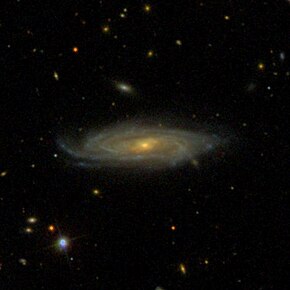NGC 3697
Appearance
| NGC 3697 | |
|---|---|
 NGC 3697 by SDSS | |
| Observation data (J2000 epoch) | |
| Constellation | Leo |
| Right ascension | 11h 28m 50.380s[1] |
| Declination | +20° 47′ 42.61″[1] |
| Redshift | 0.020884[2] |
| Heliocentric radial velocity | 6261 km/s[2] |
| Distance | 291.57 ± 24.07 Mly (89.395 ± 7.379 Mpc)[2] |
| Group or cluster | HCG 53[3] |
| Apparent magnitude (V) | 12.62[2] |
| Apparent magnitude (B) | 14.1[3] |
| Characteristics | |
| Type | SABb[2] |
| Size | 212,000 ly (65,010 pc)[2][note 1] |
| Apparent size (V) | 2.5′ × 0.7′[2][note 1] |
| Other designations | |
| UGC 6479, MGC+04-27-042, PGC 35347[3] | |
NGC 3697 is a spiral galaxy in the constellation of Leo.[2] It was discovered on 24 February 1827 by John Herschel.[4] It was described as "extremely faint, very small, extended 90°" by John Louis Emil Dreyer, the compiler of the New General Catalogue.[4] It is a member of HCG 53, a compact group of galaxies.[3]
References
- ^ a b Skrutskie, M. (2006). "The Two Micron All Sky Survey (2MASS)". The Astronomical Journal. 131 (2): 1163–1183. Bibcode:2006AJ....131.1163S. doi:10.1086/498708.
- ^ a b c d e f g h "NED results for object NGC 3697". National Aeronautics and Space Administration / Infrared Processing and Analysis Center. Retrieved 9 November 2017.
- ^ a b c d "NGC 3697". SIMBAD. Centre de données astronomiques de Strasbourg. Retrieved 9 November 2017.
- ^ a b "New General Catalog Objects: NGC 3650 - 3699". cseligman.com. Retrieved 9 November 2017.
Notes
External links
 Media related to NGC 3697 at Wikimedia Commons
Media related to NGC 3697 at Wikimedia Commons
